WILLOW CREEK GOLD
By Richard Bingham

I walked into Chucks Detectors like I did every few days just to catch up on who’s been finding what, where, and how. There was some treasure hunting buddies there looking at some maps and some nice beautiful nuggets being shown off. I could tell right off that it wasn’t California gold. It had a stitch of silver in it. It was Nevada gold. The gold from that area has more silver, so its color is a bit different.
As it turned out someone knew someone who knew someone that knew of some property for lease. At first I thought it was just another impossible daydream. After all, who would lease a spot with that kind of gold? I would be mining it myself if I owned it. What I learned, though, was the area had been owned, leased, and mined for close to a century, and now the Rail Road owned the mineral rights.
Those who knew the area said approx. 80% was mined out and no large outfit wanted to try to get the last 20. My prospecting buddies were considering a railroad offer of $5000 per year plus 10% of the gold. Well, we had 10 guys willing to put up $500 each if the gold was there. So my next step was a trip to Willow Creek.
The following week my buddy John and I loaded up the hi-banker and pans and drove the 250 miles. We grabbed a motel and headed up to the claim. This area is fairly remote and fairly dry, but has a few springs that feed the creek and holding ponds of previous miners. Heading up the canyon we could see tailing’s and junk piles holding pieces of large equipment left from previous miners, shaker boxes and screens, motors and dozers. All abandoned and rusting away.
Just as we were reaching the property entrance, we came up on an old truck and camper. Outside we saw a dog of some sort sitting next to an old man wearing tattered coveralls and boots. He was watching us very closely and looked a little upset with the fact that we were invading his privacy. We stopped, said hi, and told him what we were planning and why we were there.
Well a look of relief showed on his face as he said, “damn I thought you were the railroad.” We didn’t have to ask him what he was doing. There were pry bars and buckets and gold pans everywhere. Inside the trailer was cluttered with, well you name it. Month old dirty pans and bowls that held something that resembled food. Empty cans and trash everywhere.
After finding a place to stand, and after he determined that we were no threat, he pulled out a neatly packed box with small bottles packed inside all about 2 inches tall and clear. They looked like they could have had cough syrup in them, but now were filled with gold. All of them filled with gold. I swallowed my gum and blurted out something like, “Damn, you find all of that here?” He chuckled, then looked at me like I must have just fallen off the turnip truck. “Course I did! Think I’d be here if I didn’t? Sure as hell ain’t fishin”
After the laughter subsided he looked me in the eye and said, “I guess if you guys leased this property then I’ll show you where and how if you let me kind of be the a, care taker?” Beings he’s been taken pretty good care of the gold and beings we were not actual owners yet, we said “sure show us around”. We started up the gravel road with his dog along side wanting to chase anything and everything.
We passed by huge piles of tailing’s filling up what used to be holding ponds. You could see holes dug in the tailing’s where someone had been detecting the gravels left behind by previous mining outfits. The one thing about large outfits is they lost gold out the shakers and screens. They also lost gold off the dump trucks and everywhere in-between. They were interested in the bulk of the ore and little spills here and there were generally ignored. So if you had a good detector, and some time, you could find gold.
As we walked up the small canyon we started seeing something unusual. The sides of the canyon were cut straight up and down. Probably, forty feet in places. There was 20 feet plus of dry dusty soil, a few feet of rocky subsoil, then an unusual white streak anywhere from 6 inches to 2 feet thick. It looked a lot like charcoal or like ashes from a fire. My guess wasn’t far off. It was an ancient ash flow.
The old man said it was from an eruption thousands and thousands of years ago. He said from a volcano in Washington? Regardless where it came from, it was a definite sign of untouched ground. Whenever you saw that ash flow belt, you knew no one had disturbed the ground below. Lying under the ash flow was 3 to 5 feet of an ancient mud flow possibly caused by the same natural disaster that put the ash there. Neither was carrying gold, but what’s important is the gold bearing layer was directly under both. Maybe a foot or 2 deep and laying on a false bedrock called cleachy.
We saw right off where the old man was doing his prospecting. He was cutting under the 20 plus feet of dirt and 4 feet of gravel and ash. He would leave a pillar every 4 to 6 feet and then undercut the heavy layers and pull out buckets of nothing but good stuff. OK, now, I was thinking this guy wants to die. There is no way I would stick my head under all that rock and pound away with pry-bars and shovels. Well…”pause”.. It would have to be some pretty nice gold.
We could see why the big outfits took off when they did. So much overburden and such a small pay-layer. But gold prices were climbing. 450 an oz and every one saying 1000 in a few years, so maybe we could pick a “safe spot” and pull out a couple of buckets and see what was there. Next day we were up early, and after looking over the areas we had to choose from, we picked a spot that looked safer than most.
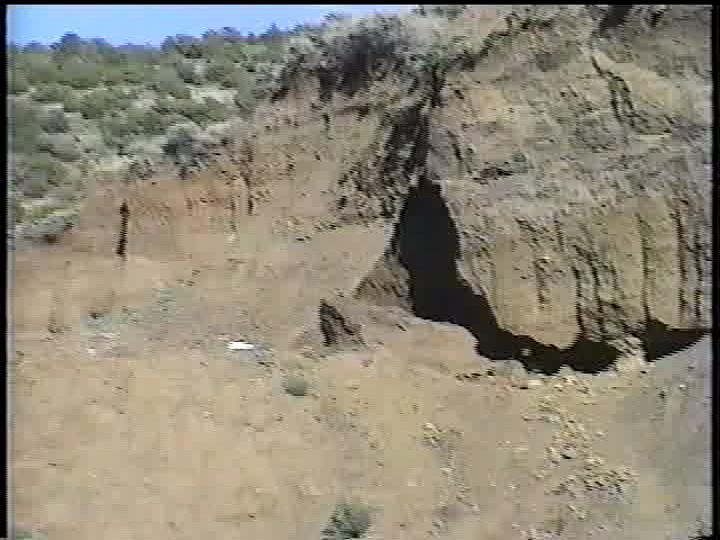
I dropped to my knees and poked a pry-bar under the layers of rock and ash. It was hard and compacted, but would yield to a few choice blows and then we would scrape and load it into buckets. It took over an hour to fill 2 buckets. I was beginning to wonder what we got ourselves into. We had water nearby so we set up my hi-banker and ran the 2 buckets slowly. We shut down and washed out the carpets and started panning the concentrates.
HOLY MOLY! I was seeing color everywhere. All kinds of gold. Course gold, pickers and a small nugget. Damn, 2 buckets and over a quarter oz of gold. Well, we did what anyone would do in such a place. We grabbed pry-bars and buckets and went to work. We had already dug farther under the ledge than we should have, so the only thing to do was take a little out of some of the pillars.

This seam of gold bearing gravels was up both sides of the wash, but without heavy equipment most of it was untouchable with hand tools. Tons of rock had sluffed off and buried much of it. So with just 2 days and a hi-banker, we had to pick a place where we could grab a few more buckets without moving the bulk of the hill. This can get kind of nerve racking. You are constantly flinching when a rock drops somewhere close and we knew we were living on the edge.
Gold can do that to you. It can make you take chances. You can deceive yourself into a false sense of security. Knowing you are digging good gold-bearing gravels can make you take risks. The more you get away with it, the more chances you take. We kept cutting away pillars a little at a time and kept pulling more gravel and rocks from the pay-layer until we filled 4 buckets about two thirds full.
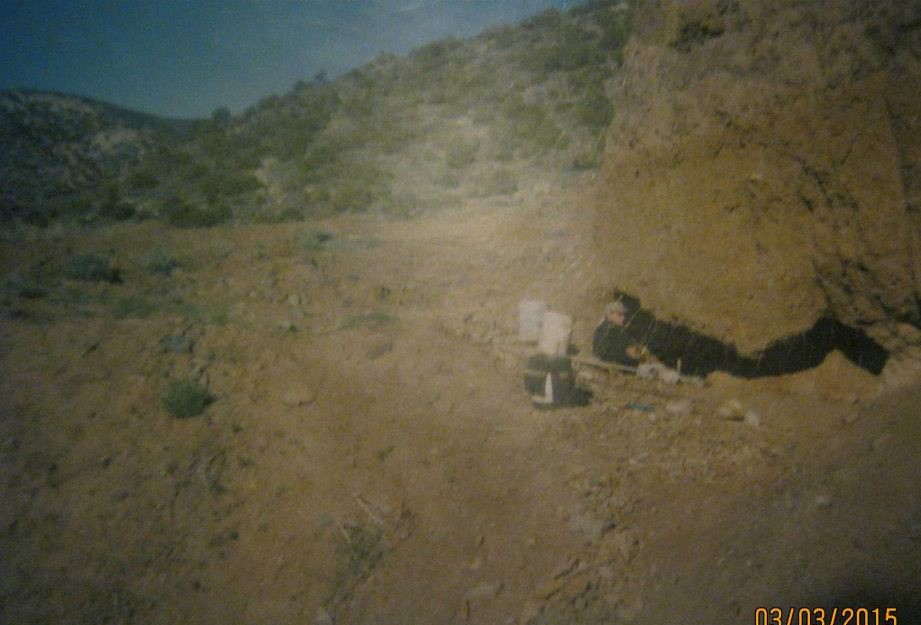
We stood up and looked at each other and started talking about calling it a day when, from the corner of my eye I saw or felt a shift in the rock over our heads. I’m not sure if we even had time to think of what we saw or felt because in an instant everything came crashing down.. I dove left and John dove right. As I was in midair I felt the dirt and rocks trying to suck me under. It grabbed my leg and I pulled free and that was that.
Next thing I thought, after what seemed like the whole mountain came crashing down, was, ‘Where’s john?’ My heart sank. I yelled again. Or maybe for the first time. “John!” Through the dust I could see him on the other side. Whew! That’s a feeling I don’t ever want to feel again. John was safe. Everything happened so fast, yet it all seems like slow motion. Just minutes before it caved in, we were on our knees and our heads were well inside of the “grave” we had dug for ourselves. For some reason we both decided it was time to quit.
The buckets were not as full as we usually filled them, and we had plenty of daylight and energy left, but something or someone made us decide to get out and that saved our lives. It could have been just blind luck, but I think God was watching over us that day. I lost some pry-bars and 2 of our buckets were crushed. I had a nice bruise on my leg, but hey, we saved most of the gold and that’s what counts.
The gold we panned from those 4 buckets was very impressive. Again, around quarter oz a bucket, but was it worth losing our lives? We thought about it and hard as it was to walk away, we did. But not for long. Now we knew we needed to find some equipment and do the job right.
PART TWO
Ok, that was step one. Fact one. There is gold at willow creek. Fact two and step 2. We need bigger toys and bigger tools. Our fellow partner from the prospecting shop knew exactly what we needed. He already had a trommell at Ociolla, near Ely, Nevada, along with the equipment it takes to work it. But because of its size and construction, it wasn’t feasible to haul it up north. So he was already making plans for buying one in California.
I’m not sure how he found it, but a friend of his in Northern California had just made a beautiful trommell for someone else who couldn’t pay for it and this baby was all self contained and easily moved with a truck. It was very well made. It was designed to be fed with a conveyor belt, but with a small modification was redesigned with a screen and hopper. Now we could use a backhoe to feed the material.
There were hi pressure washers in the header box, which wetted and pushed the material through a 4 inch mesh screen, which then fed into a rotating cylinder approx. 4 foot wide. The cylinder was 15 feet long and rotated with hi pressure washers and heavy chains inside banging away breaking up the clay balls and gravel into a classified slurry. It separated the rocks from the good stuff with 3/4 inch holes that allowed the washed and sized material to separate in the 12 foot twin sluices.
It was designed to run on one 10 horse engine that turned the trommell and a 5 horse briggs with a Keene pump. With the right material, it could process 10 yards an hour. A well designed nugget trap was built inside just in case something big made it past the screens. In 6 weeks we had found the equipment, made arrangements for it to be trucked to a motel near the site, and found a back hoe within 10 miles of our claim. Things looked good.
We made it to the Motel and waited not long for the trommell. I still can’t believe a station wagon pulled up with its rear bumper almost dragging, pulling this gold saving machine in tow. The next day we hooked it up to my truck and hauled it up the mountain. This in itself was no easy task.
By the time we reached the area we were to set up, my little Ford Ranger was in low range first gear and I was wishing I had a bigger truck. Our man with the backhoe was right behind us. Once there, it was surprisingly easy to set things up. We leveled the trommell next to a holding pond and set the pump up 50 feet away. We showed the backhoe operator what we needed him to do and where the paystreak was. Everything looked good, or did it?
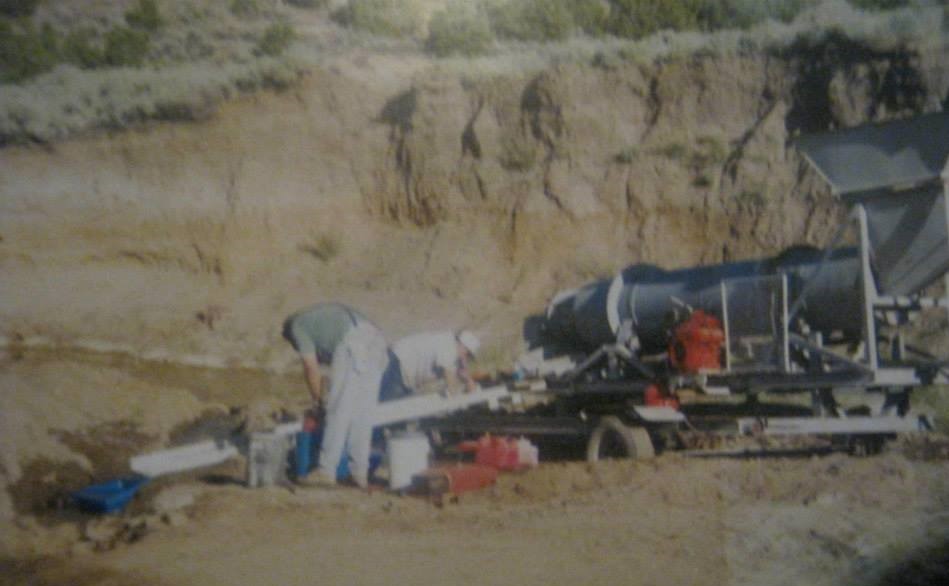
Problem one. A back hoe, even with an extended bucket couldn’t reach up to the top of the hill of waste rock, and wasn’t capable of removing such large amounts of worthless material. It was a little spooky putting it right up next to the bank that you wanted to pull down. If too much material pulls loose, or a large bolder gets away, then the backhoe and operator has a problem.
Well, with us set up and ready to run material, we had no choice but to run whatever he could safely remove from the hillside through the trommell and hope we got lucky. The trommell ran beautifully. It took a bit of time and effort to get the feed constant. We needed to move the tailing’s pile, but other than that it processed the material beautifully. After 5 or 6 hours of running the trommell and darkness creeping in, we decided to shut down for the night.
The carpets were pulled and quickly washed out into a tub. John grabbed some of the material and did a speed pan. This guy can pan as fast as anyone and still gets the fines. There was several course pieces and a nice showing of flour, so all in all, we felt pretty good about things.
The next morning we were up and running by daylight and ran almost constantly for the entire day. Now this is the way to get gold! Sure there was some running around and some shoveling, but it sure beat putting your life on the line for a couple buckets of the “good stuff”.
My job was to keep the Briggs 5 horse pumping water to the sprayers and at the other end keep the tailing’s from backing up. Oh yea, I was the last look for that 4 inch nugget that might sneak past the nugget trap. I figured that was the most important part of the entire operation. If a large nugget left the trommell without hitting the sluices, then our metal detectors would have spotted it. Always check your tailing’s. ALWAYS.
Everything was running smooth. Well, almost everything. We still had the problem of mixing the 20 feet of subsoil into the 2 or 3 feet of gold bearing gravels. We tried to talk the backhoe operator into finding a way out of the canyon and onto the top of the hillside to then pull the soil away before trying to get to the good stuff. But the walls were steep and with just a few days to run, we had no choice but to let him decide what and how the walls were to be removed.
While we ran what we could get out of the walls with the back hoe, a few of our partners were doing pretty good running hi-bankers and metal detecting. There were a few pickers and course pieces with flour gold a plenty. We ran the trommell 2 solid days and had about as much fun as you could have working and digging for gold.
The best part of the whole day is shutting down and picking through the ripples of the sluices looking for gold. What’s even better is seeing it laying there waiting to be picked up and admired. There’s nothing like it. I’ve shot deer and caught some nice fish, but seeing that gold is the ultimate in satisfaction.
Knowing you did it. Knowing you found it. (pause). It doesn’t get any better than that!
I have wondered how such a remote and lost place such as this could have been any ones destination. First, getting to the area is tough. There’s 15 or 20 miles of dry flatland with no water, no trees, and no sign of life. The flat treeless desert turns to hills with brush and grasses. Older cottonwoods and Willow trees show up at the mouth of the canyon. I sure would have liked seeing this place untouched 100 years ago. The place wouldn’t have looked like much.
Probably a spring and a small creek that ran dry in the summer. Maybe a prospector dry panned a bit, saw some color, then walking upstream might have caught a glimpse of the ash flow. Maybe he would have panned a little out of the drainage, then maybe picked a canyon wall and panned some nice nuggets.
That is how it all starts. Just someone who had enough energy, drive, or ambition to see the possibilities to take the next step. You won’t find gold without effort and you can’t find gold if you don’t look.
Once you find Gold, give it your best shot. Somewhere I read something that sums it all up,
“It’s not how much you find. It’s the finding.”
It’s the feeling of knowing you did it. You set out on a journey; an adventure. And you use your skills and knowledge and conquer. You “saw the elephant.”
ARTICLE WRITTEN BY RICHARD BINGHAM
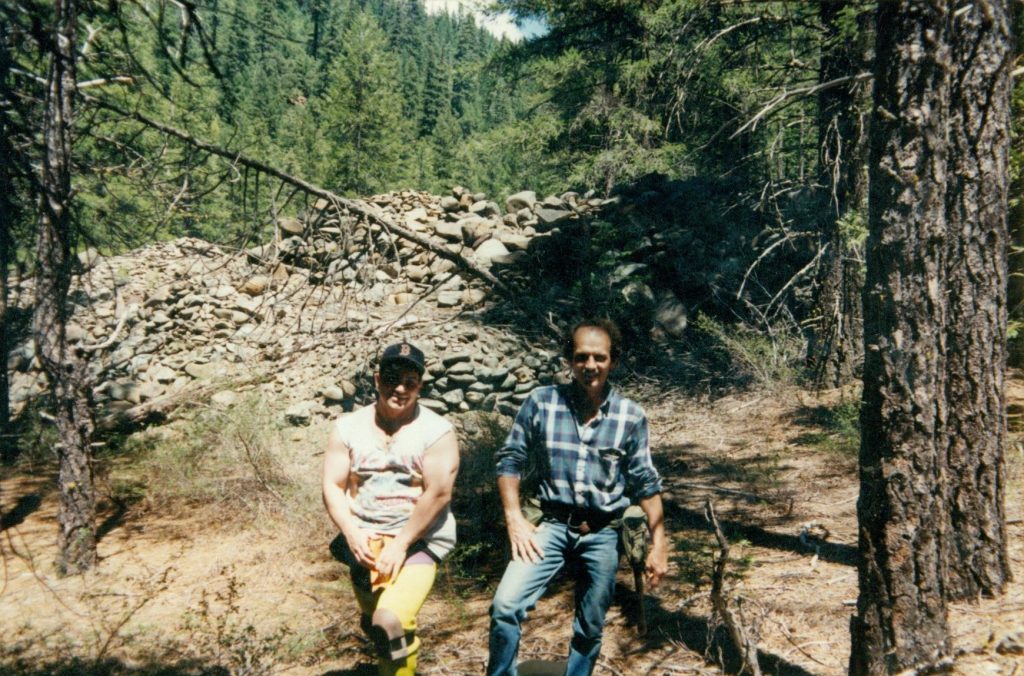
.
.
.
,

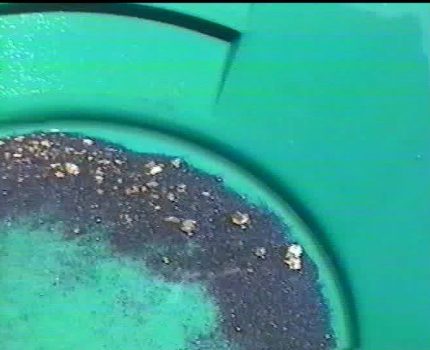
I still feel it when I read what we had done! Thank you for posting my story
Nice buddy, got to come visit a bit.Ill make it down there!! Nice adventure!!!!❤️👍😀
Excellent story and ends with gold. No worse for ware and a hole lot smarter. Super cool trommell. g